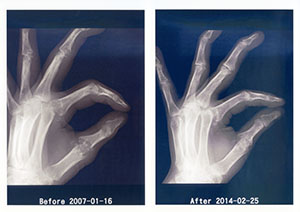In the era of biological disease-modifying drugs (DMARDs) for the treatment of rheumatoid arthritis (RA), we commonly observe a reduction in joint inflammation. Recently, several reports suggested that the calcineurin inhibitor, tacrolimus, might increase bone formation in RA and protect against articular cartilage matrix degradation of osteoarthritis-chondrocytes in vivo.1,2 We describe a patient with erosive RA who showed significant joint remodeling following the addition of tacrolimus to a regimen of low-dose methotrexate (MTX).
The Case
The patient is a 42-year-old female with a five-year history of RA who had been treated with a weekly dose of 8 mg MTX and 5 mg prednisolone daily. On her visit to our clinic she was noted to have a DAS28 score of 6.43. An X-ray of the hand [See “Before” image (left) in Figure] demonstrated severe joint and bone destruction, especially of the third and fourth proximal phalanges and bone demineralization. We prescribed tacrolimus at 1 mg daily. After three months, she described improvement. The DAS28 score was 2.82 and her C-reactive protein level had normalized, allowing us to wean her off prednisolone. Over the next seven years, the dose of tacrolimus has been maintained and the MTX dose was reduced to 6 mg per week. A hand X-ray showed marked bone remodeling of the phalanges [See “After” image (right) in Figure].
Discussion
Calcineurin inhibitors are thought to increase the risk of developing osteopenia, but tacrolimus in some animal models show there may be greater bone formation than bone resorption.3,4 We suggest that low-dose tacrolimus may have a potential role in the management of erosive arthritis. (posted 5/22/14)
Yuichi Nishioka, MD, is the director and CEO of the Nishioka Clinic for Rheumatic Diseases and Allergic Diseases in Yamanashi, Japan.
References
1. Kang KY, Ju JH, Song YW, et al. Tacrolimus treatment increases bone formation in patients with rheumatoid arthritis. Rheumatol Int. 2013;33(8):2159–2163.
2. Siebelt M, van der Windt AE, Groen HC, et al. FK506 protects against articular cartilage collagenous extra-cellular matrix degradation. Osteoarthritis Cartilage. 2014;22(4):591–600.
3. Tamler R, Epstein S. Nonsteroid immune modulators and bone disease. Ann N Y Acad Sci. 2006;1068:284–296.
4. Yoshikawa T, Nakajima H, Yamada E, et al. In vivo osteogenic capability of cultured allogeneic bone in porous hydroxyapatite: Immunosuppressive and osteogenic potential of FK506 in vivo. J Bone Miner Res. 2000;15(6):1147–1157.

